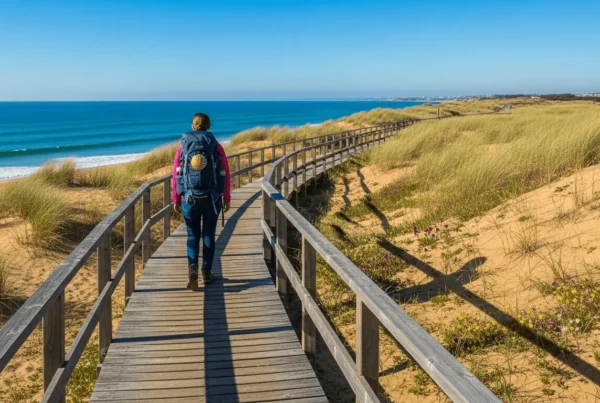Imagine this: you’ve been dreaming of walking the Camino for months. You’ve planned everything, packed your backpack, and set off on your journey. But within a few days, your feet are covered in painful blisters, your muscles ache, and every step feels like torture. Sound familiar?
Blisters and injuries are among the most common reasons pilgrims struggle or even abandon their Camino. But the good news is: they are completely preventable! In this guide, we’ll walk you through 10 foolproof tips to protect your feet, avoid unnecessary pain, and ensure a smooth and enjoyable pilgrimage.
Understanding the Causes of Blisters and Injuries
Before we get to the solutions, let’s identify the most common reasons why pilgrims suffer from blisters and injuries:
✅ Wearing the wrong footwear – New or poorly fitted shoes can cause friction.
✅ Socks that don’t absorb moisture – Wet feet = more blisters.
✅ Ignoring foot care – Not addressing minor discomforts early leads to bigger problems.
✅ Overloading your backpack – Extra weight strains your legs and back.
✅ Not warming up or stretching – Increases the risk of muscle injuries.
Now that we know the risks, let’s go over 10 foolproof ways to prevent them.
1. Choose the Right Footwear (and Break Them In!)
Your hiking boots or trail runners should fit well with at least a thumb’s width of space at the front.
Test them out months before your journey. Walk at least 100 km in them before starting the Camino.
Avoid brand-new shoes! Breaking them in prevents unexpected discomfort.
✅ Recommended option: Trail runners for lightweight comfort or boots for ankle support.
2. Wear High-Quality Socks (Avoid Cotton!)
Merino wool or synthetic socks help wick away moisture.
Double-layer socks (like WrightSock) help reduce friction.
Always carry extra pairs to change during the day if your feet get sweaty.
✅ Pro Tip: Some pilgrims wear a thin silk or nylon liner sock under their main socks for extra protection.
3. Keep Your Feet Dry and Clean
Wet or sweaty feet are a breeding ground for blisters.
Change socks at midday if they get damp.
Use foot powder to reduce moisture.
Air out your feet whenever you take a break.
✅ Pro Tip: Carry anti-blister powder like Gold Bond or baby powder.
4. Use Lubricants or Tape for Extra Protection
Apply Vaseline or anti-chafing balm (e.g., Body Glide) to your feet before walking.
Tape high-friction areas (heels, toes, or sides of the foot) using KT tape or medical tape.
Test different methods before your Camino to see what works best for you.
✅ Pro Tip: Some pilgrims swear by Compeed blister patches for preemptive protection.
5. Cut Your Toenails Before Starting the Walk
Long toenails can press against your shoes, causing pain and black toenails.
Trim them a few days before walking (not the night before, to avoid sensitivity).
✅ Pro Tip: Cut nails straight across to avoid ingrown toenails.
👣 Want to Choose the Perfect Footwear for the Camino? 👣
Preventing blisters starts before you even take your first step on the Camino! The right pair of shoes or boots can make all the difference in ensuring a pain-free and enjoyable walk. But with so many options out there, how do you choose the best one?
👉 Check out our Complete Footwear Guide for the Portuguese Coastal Way
Inside, you’ll discover:
✅ The best types of shoes for different walking styles
✅ Trail runners vs. hiking boots – which is better?
✅ Waterproof or breathable shoes? What actually works on the Camino
✅ How to properly break in your shoes to avoid injuries
💡 Don’t let poor footwear ruin your journey—prepare your feet before you hit the trail!
6. Don’t Overload Your Backpack
A heavy backpack = more stress on your knees, ankles, and back.
Keep your pack under 10% of your body weight (e.g., if you weigh 70 kg, your backpack should be max 7 kg).
✅ Pro Tip: If possible, use a luggage transfer service to avoid carrying excess weight every day.
7. Stretch Every Morning and Evening
Warm up your muscles before you start walking to prevent cramps and injuries.
Stretch your calves, hamstrings, quads, and feet every morning and after finishing for the day.
✅ Pro Tip: Yoga and foot massages help relax tired muscles.
8. Listen to Your Body and Take Breaks
If you feel a hot spot (the early sign of a blister), stop immediately and apply tape or a blister patch.
Take regular breaks to let your feet rest and breathe.
Never push through pain—address small problems before they become big ones.
✅ Pro Tip: Walk shorter distances in the first few days to allow your body to adjust.
9. Train Before the Camino
If you’re not used to walking long distances, start training at least 2 months before.
Walk with your backpack and shoes to simulate the real experience.
Increase distance gradually to prevent injuries.
✅ Pro Tip: Train on different terrains (hills, uneven paths, etc.) to prepare for varying conditions.
10. Know Basic First Aid for Blisters and Injuries
Even with preparation, blisters and soreness can still happen. Be ready:
For blisters: Clean the area, apply antiseptic, cover with a blister patch (e.g., Compeed).
For muscle pain: Use ice packs, stretch, and take anti-inflammatory medication if necessary.
For knee pain: Try using trekking poles to reduce strain on your joints.
✅ Pro Tip: Carry a small first aid kit with plasters, tape, antiseptic wipes, and ibuprofen.
Conclusion
Final Thoughts: Take Care of Your Feet, and They’ll Take Care of You!
Walking the Camino is a life-changing experience, but poor foot care can ruin it. By following these 10 foolproof tips, you’ll minimize discomfort and enjoy every step of your journey.
Join Our Community!
Share your favorite Camino footwear and foot care tips with fellow pilgrims in our WhatsApp Community. Let’s support each other on this incredible journey!





